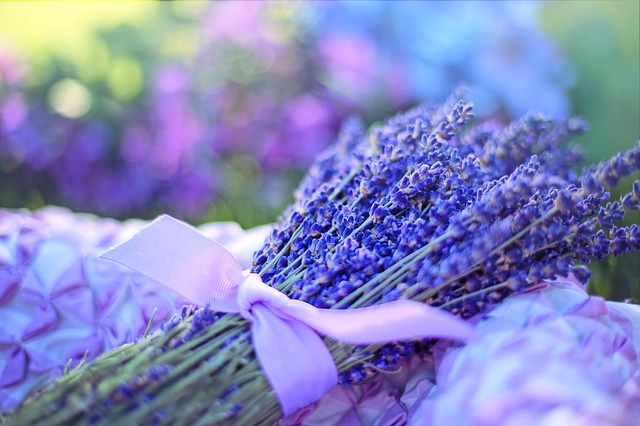Preventing Scarring and Healing Your Skin With Aromatherapy Oils by Misty Rae Cech

Pure essential oils have a long history of use in natural skin care. These wonderful phytochemicals provide a great breadth of natural, medicinal components well-known for healing damaged skin, as well as reducing the appearance of old scars from wounds, acne and other incidents. Essential oil blends for these applications are gentle, safe for regular use, and have a wonderful aroma to boot!
There are a few primary oils used in skin repair; additional oils may be added to your liking (to improve aroma, or add further skin-supportive properties), but here, we’ll concentrate just on the commonly used oils for skin damage. First, and possibly most important, is Helichrysum Italicum, also known as Everlasting. This oil with a lovely earthy aroma is distilled from the brightly-colored, daisy-like flowers of a strongly aromatic herb native to the Mediterranean region. Helichrysum is one of the most highly regarded oils in aromatherapy for it’s broad range of healing properties for body tissues. It is strongly anti-inflammatory, and has a high concentration of regenerative diketones found only in this oil. It is a bit more expensive due to it’s low yield in processing, but produces it’s wonderful effects in very small doses.
Helichrysum is the foundation of many blends for healing the skin, and can be used by itself in a synergistic carrier oil such as Rosehip seed. This combination may be all that is needed to speed the healing of recent wounds – though often a little Lavender oil is added as well. Kurt Schnaubelt, one of America’s leading aromatherapists notes in his quintessential guide “Advanced Aromatherapy” that Helichrysum essential oil and Rosehip seed can “heal wounds with minimal or no scarring”.
As mentioned above, Lavender is often included in skin care blends – it has gentle anti-inflammatory and tissue regenerative properties, along with very soothing, anti-anxiety aroma. Lavender essential oil itself began the modern aromatherapy revolution when a scientist burned his hand in a laboratory accident, and after cooling the wound in a beaker of Lavender found the wound to heal remarkably quickly. It is also thought to ‘synergize’ or improve the efficacy of other essential oils in combination.
Next up is the essential oil distilled from the leaves of common Sage, or Salvia officinalis. Sage is used in low concentrations in very specific conditions – where the scars are old and require a little extra phytochemical power to heal. Sage oil can bring circulation to the area, and can assist the scarred area of the skin to regenerate, particularly in concert with other oils. Sage can be used in stretch mark formulas, but should only be employed post-partum because of the high thujone content of the oil.
Rosemary is an essential oil with a wonderful aroma that is used in many skin care blends. The Verbenone chemotype is called for here as, like Helichrysum and Lavender, contains regenerating ketones (the Cineol type does not). Rosemary will also stimulate cellular metabolism, improving the nutrition and waste cycling of skin cells.
Finally, these essential oils need to be diluted carrier oils, which are seed or nut oils made up of fatty acids. These oils help the skin absorb the essential oils, and provide important nutritive oils to help the skin heal and look its best. The most important is Rosehip Seed oil, cold-pressed from Rosehip Seeds native to mountainous regions of South America. In addition to its unsaturated fatty acids, this oil contains natural vitamin A compounds similar in effect to the pharmaceutical preparation Retin-A but without the over drying or redness that often accompanies its use. Hazelnut oil is also a wonderful carrier well tolerated by all skin types; its gentle astringent qualites prevent the skin from feeling oil upon application.
Now for the recipes. For effective wound healing of recent cuts and scrapes (and has been used successfully on surgical incisions), to 1 ounce Hazelnut oil and 1 ounce Rosehip seed oil add 1 milliliter of Helichrysum essential oil and 1 milliliter of Lavender essential oil – apply twice a day for 7 to 10 days. For older scars from wounds or acne, including keloid scars, replace the Lavender in the previous recipe with Sage essential oil. Apply regularly for 3 to 6 months. For the healing of stretch marks, post partum, use 1 ounce Rosehip seed and 1 ounce Hazelnut oil with 1 milliliter Sage essential oil and 2 milliliters with Rosemary Verbenone essential oil; again use for 3 to 6 months.
So these are just a few skin care formulas commonly used in aromatherapy. Many more exist for a great variety of skin conditions – there is much information available on the internet or in bookstores. Remember, when creating your own blends, be conservative with the amounts of essential oils – they do work in small amounts. Also, it’s always fun to add to these recipes one or more of your favorite aromatic oils – Jasmine, Ylang Ylang, Rose or other oils can add a lovely complex aroma to the blend; one that you’ll enjoy wearing. Be creative, be safe and have fun!
About the Author:
Misty Cech, ND, is the owner of Ananda Aromatherapy and Synergy Essential Oils. More information about using essential oils in your life at anandaapothecary.com






